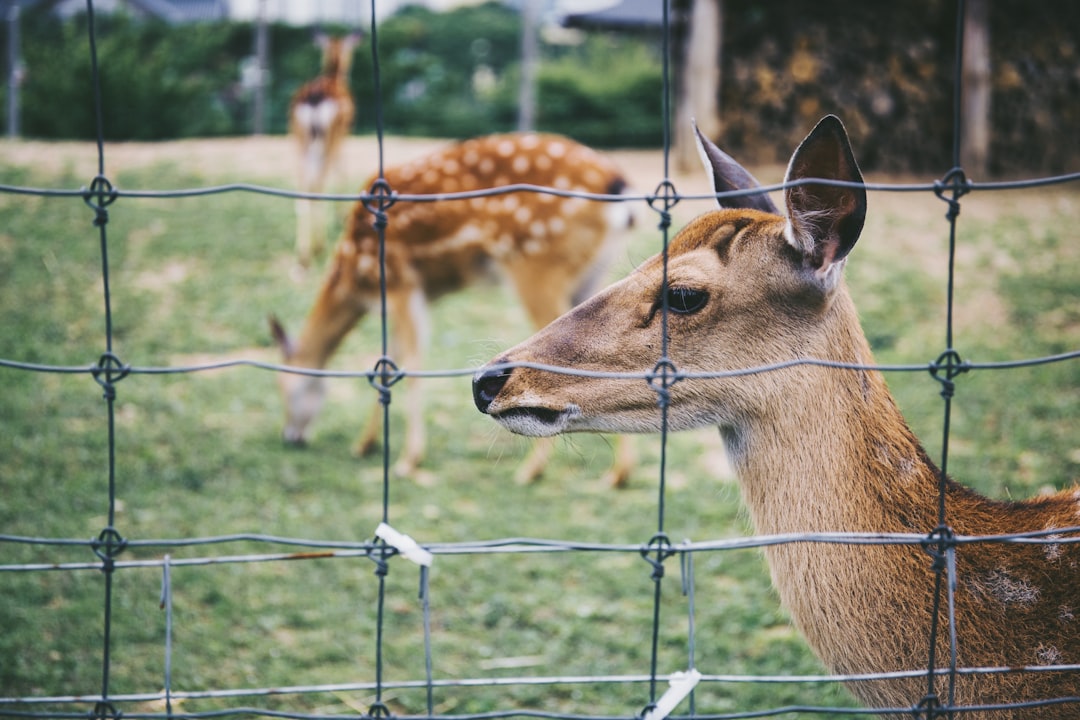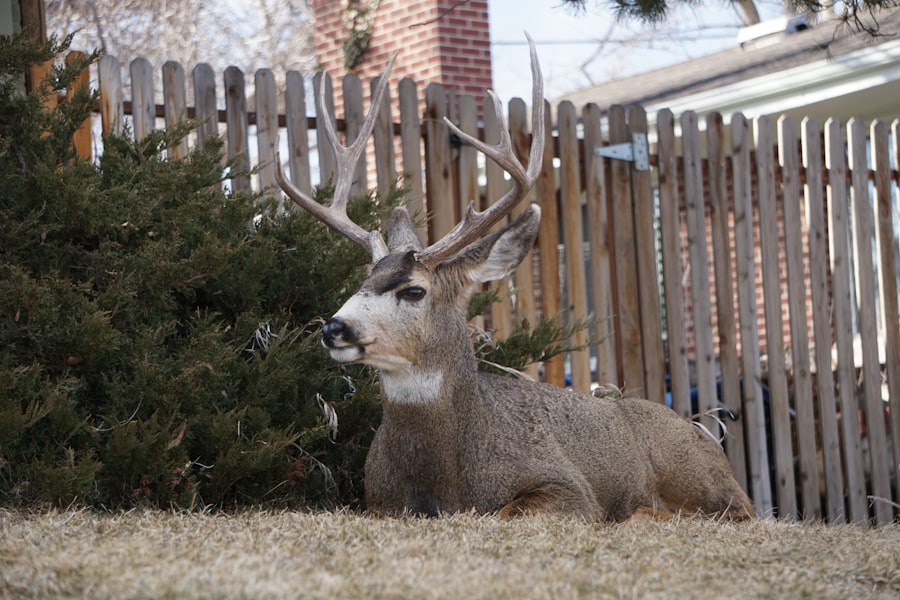Deer-proof your yard with these tips

The deer problem in residential areas has become a growing concern for homeowners across the country. As urbanization continues to encroach on natural habitats, deer are finding their way into neighborhoods in search of food and shelter. While these majestic creatures may be a sight to behold, they can wreak havoc on gardens and landscaping, causing frustration and financial loss for homeowners. It is important to address the issue of deer in residential areas in order to protect our gardens and maintain the beauty of our landscapes.
Key Takeaways
- Understanding the deer problem in your yard is crucial to finding the right solution.
- Choosing deer-resistant plants for landscaping can help prevent damage to your garden.
- Building a deer fence using the right materials and techniques can be an effective solution.
- Using natural or chemical deer repellents can help keep deer away from your yard.
- Creating a deer-unfriendly landscape design and avoiding common attractants can also deter deer.
Understanding the Deer Problem in Your Yard
There are several reasons why deer are attracted to residential areas. One of the main reasons is the availability of food. Deer are herbivores and will eat a wide variety of plants, including flowers, shrubs, and vegetables. Residential areas often provide an abundance of these food sources, making them an attractive feeding ground for deer. Additionally, deer are drawn to residential areas because they offer shelter from predators and harsh weather conditions.
The negative effects of deer on gardens and landscaping can be significant. Deer can cause extensive damage to plants by browsing on leaves, stems, and flowers. They can also trample on plants, causing them to become uprooted or damaged. This can result in the loss of valuable plants and the destruction of carefully designed landscapes. Furthermore, deer can spread diseases such as Lyme disease through ticks that they carry, posing a health risk to humans and pets.
Choosing Deer-resistant Plants for Landscaping
One effective way to deter deer from your yard is by choosing plants that are less appealing to them. Deer-resistant plants typically have characteristics that make them less palatable to deer, such as strong scents or textures that deer find unappealing. Some examples of deer-resistant plants include lavender, yarrow, daffodils, and butterfly bush.
It is important to note that while these plants are considered deer-resistant, they are not completely deer-proof. If deer are hungry enough, they may still eat these plants. However, by incorporating a variety of deer-resistant plants into your landscaping, you can reduce the likelihood of deer causing significant damage to your garden.
Building a Deer Fence: Materials and Techniques
| Materials | Techniques | Cost | Effectiveness |
|---|---|---|---|
| Wooden posts | Post and rail | High | |
| Metal T-posts | Wire mesh | Medium | |
| Polypropylene mesh | Staple to wooden posts | Low | |
| Electric fence wire | High-tensile wire | Very high |
One of the most effective ways to keep deer out of your yard is by installing a deer fence. There are several types of fences that can effectively deter deer, including electric fences, woven wire fences, and plastic mesh fences. Electric fences are particularly effective because they deliver a mild electric shock to deer when they come into contact with the fence, deterring them from attempting to enter the yard.
When installing a deer fence, it is important to consider the height and strength of the fence. Deer can jump high, so a fence that is at least 8 feet tall is recommended. Additionally, the fence should be sturdy enough to withstand the weight and pressure of a deer attempting to push through it. It is also important to ensure that the fence is properly secured to the ground to prevent deer from crawling underneath it.
Using Deer Repellents: Natural and Chemical Options
Another option for deterring deer from your yard is by using deer repellents. There are both natural and chemical options available. Natural repellents often use strong scents or tastes that deer find unpleasant, such as garlic or predator urine. These repellents can be sprayed directly onto plants or applied around the perimeter of the yard.
Chemical repellents, on the other hand, often contain ingredients that deter deer through taste or smell. These repellents can be applied directly to plants or used as a barrier around the yard. It is important to follow the instructions on the repellent carefully and reapply as needed, especially after rain or watering.
Creating a Deer-unfriendly Landscape Design

In addition to choosing deer-resistant plants, you can also incorporate design elements into your landscaping that discourage deer from entering your yard. For example, planting thorny or prickly plants along the perimeter of your yard can create a physical barrier that deer are less likely to attempt to cross. Additionally, using rocks or gravel in certain areas of your yard can make it less appealing for deer to walk on.
Another design element that can deter deer is the use of raised beds or containers for planting. Deer are less likely to jump into raised beds or containers, making them a good option for protecting vulnerable plants. Additionally, incorporating structures such as trellises or arbors into your landscaping can create obstacles that deer are less likely to navigate.
Avoiding Common Deer Attractants in Your Yard
There are several common deer attractants that you should be aware of and take steps to reduce in your yard. One of the main attractants is bird feeders. Deer are attracted to the seeds and grains in bird feeders, so it is important to place them out of reach of deer or use baffles to prevent deer from accessing them.
Fruit trees and vegetable gardens are also attractive to deer. If you have fruit trees in your yard, it is important to pick up fallen fruit regularly and consider using netting to protect the fruit from being eaten by deer. Similarly, if you have a vegetable garden, it may be necessary to install a fence around it to keep deer out.
Proper waste disposal is another important factor in reducing deer attractants. Deer are attracted to garbage and compost piles, so it is important to secure garbage cans and compost bins to prevent deer from accessing them. Additionally, avoid leaving pet food outside as this can also attract deer.
Installing Motion-activated Sprinklers to Deter Deer
Motion-activated sprinklers are another effective method for deterring deer from your yard. These sprinklers work by detecting motion and then spraying a burst of water in the direction of the motion. The sudden spray of water startles deer and deters them from entering the yard.
There are several benefits to using motion-activated sprinklers. First, they are a humane and non-lethal method of deterring deer. Second, they can be easily installed and adjusted to cover specific areas of your yard. Finally, they are a low-maintenance option, as they only activate when motion is detected.
Planting Deer-deterring Herbs and Flowers
In addition to choosing deer-resistant plants, you can also incorporate specific herbs and flowers into your landscaping that deer dislike. Some examples of herbs that deer dislike include rosemary, sage, and thyme. These herbs have strong scents that deer find unappealing. Similarly, there are several flowers that deer tend to avoid, such as marigolds, daffodils, and foxglove.
When incorporating these plants into your landscaping, it is important to consider their placement. Planting them near more vulnerable plants can help deter deer from approaching those plants. Additionally, consider planting them in clusters or borders to create a barrier that deer are less likely to cross.
Using Visual and Audio Deterrents to Keep Deer Away
Visual and audio deterrents can also be effective in deterring deer from your yard. Scarecrows are a classic visual deterrent that can be effective in keeping deer away. Additionally, reflective tape or shiny objects such as aluminum foil can create flashes of light that deter deer.
Audio deterrents such as ultrasonic devices or radios can also be effective in deterring deer. Ultrasonic devices emit high-frequency sounds that are unpleasant to deer but not audible to humans. Radios can be set to play loud music or talk radio programs that deter deer from approaching.
Seeking Professional Help for Persistent Deer Problems
If you have tried various methods to deter deer from your yard but are still experiencing persistent deer problems, it may be time to consider hiring a professional. A professional wildlife control expert can assess your property and recommend the most effective methods for deterring deer. They may also offer services such as trapping and relocating deer or installing more advanced deterrent systems.
It is important to note that in some areas, it may be illegal to trap or relocate deer without a permit. Therefore, it is important to check with your local wildlife agency or municipality before attempting to trap or relocate deer on your own.
In conclusion, the deer problem in residential areas is a growing concern for homeowners. Deer can cause significant damage to gardens and landscaping, making it important to address the issue. There are several methods for deterring deer from your yard, including choosing deer-resistant plants, installing a deer fence, using repellents, creating a deer-unfriendly landscape design, avoiding common deer attractants, installing motion-activated sprinklers, planting deer-deterring herbs and flowers, and using visual and audio deterrents. If these methods are not effective, it may be necessary to seek professional help. By taking action to protect your landscaping and garden, you can enjoy the beauty of your yard without the frustration of deer damage.
If you’re wondering how to keep deer out of your yard, you’ll find some helpful tips in this informative article from Lawn World. They provide practical solutions to deter these graceful yet pesky creatures from wreaking havoc on your garden. From installing deer-resistant plants to using motion-activated sprinklers, this article offers a range of effective strategies. For more insights on protecting your yard from deer, check out the full article on Lawn World’s website: https://www.lawnworld.com/how-to-keep-deer-out-of-your-yard.
FAQs
What are some effective ways to keep deer out of my yard?
There are several effective ways to keep deer out of your yard, including installing a fence, using deer repellents, planting deer-resistant plants, and using motion-activated sprinklers.
What type of fence is best for keeping deer out?
A fence that is at least 8 feet tall and made of a material that deer cannot easily jump over or through, such as woven wire or mesh, is best for keeping deer out of your yard.
What are some natural deer repellents?
Some natural deer repellents include planting deer-resistant plants, using strong-smelling herbs like lavender and rosemary, and hanging bars of soap or bags of human hair around your yard.
What are some deer-resistant plants?
Some deer-resistant plants include lavender, rosemary, daffodils, alliums, and marigolds. It’s important to note that no plant is completely deer-proof, but these plants are less likely to be eaten by deer.
How do motion-activated sprinklers work?
Motion-activated sprinklers work by detecting movement in your yard and spraying a burst of water in the direction of the movement. This startles the deer and makes them less likely to return to your yard.



